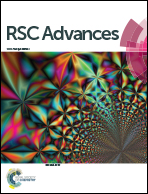Simultaneous determination of heavy metals in biological samples by a multiple-template imprinting technique: an electrochemical study†
Abstract
In order to make people aware of the contamination of heavy metals in our daily life by inappropriate food intake, we have studied the contents of copper, cadmium, and lead in various components of our biota (soil, water, and plants, i.e. fruits and vegetables), collected from different areas (normal, industrial, coal-mine, river, and hill areas). For the accurate and rapid sensing of these metal ions, a multi-template imprinted nanowire modified electrochemical sensor was reported. The imprinted nanowire was synthesized using multiwalled carbon nanotubes as a core, on which a layer of conducting polyarginine is cast using an electro-polymerization technique. To study the total uptake of food-borne Cu(II), Cd(II), and Pb(II) ions in the human body, blood samples of six people were taken based on their different diets in their daily routine. Moreover, during the soil, water and plant analysis, it was observed that plants growing in a contaminated environment have a large accumulation of metal ions in their leaves and fruits. One more study was performed to explore ‘how much heavy metal we are taking in from our regular diet?’ and it was perceived that some of the food, which has lower concentrations of copper ions, can release a bigger amount of metal ions after digestion.


 Please wait while we load your content...
Please wait while we load your content...